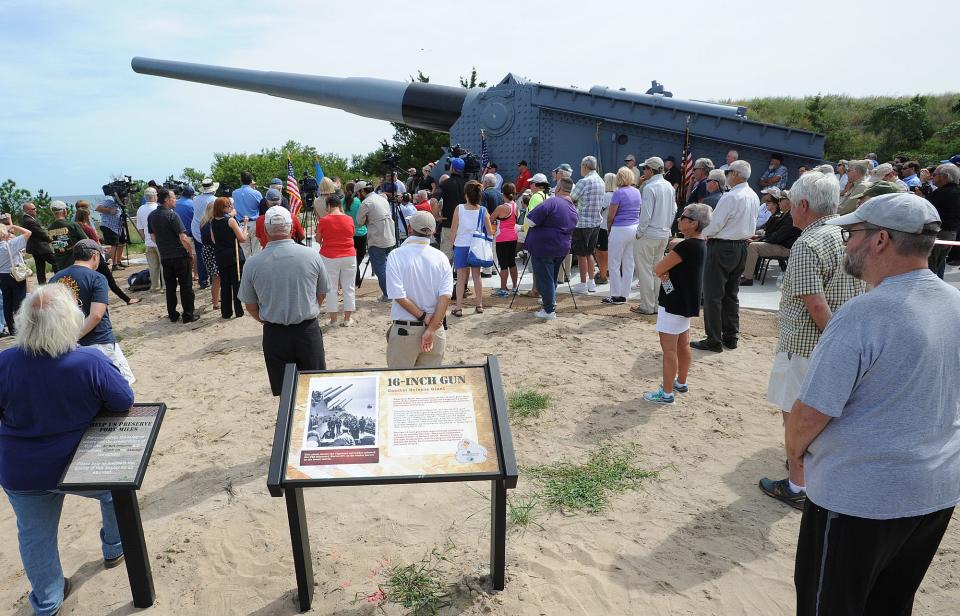In World War II, how Fort Miles Players helped relieve the tedium with musical revue
“A new musical revue, ‘Dog Tags of 1943,’ by the Fort Miles Players,” the Wilmington Sunday Morning Star announced on March 14, 1943, “will have its initial ‘First Night’ performance Monday night in the post theater at Fort Miles.”
Preview performances of the new show were held earlier that week in the fire hall at Rehoboth Beach and in Georgetown before audiences composed of service personnel, who, the newspaper reported, “predict that it will be another smashing hit. “
By 1938, the deteriorating situation in Europe convinced the United States government to upgrade the defenses at the mouth of the Delaware Bay. Land was purchased near Cape Henlopen, and in 1940, construction began on Fort Miles, one of the most important military installations on the American Atlantic coast.

Two months after construction began, work accelerated when the Japanese attacked Pearl Harbor and the United States entered World War II. At the same time, German submarines appeared off the coast, and the enemy U-boats began torpedoing merchant ships and United States Navy vessels.
Soldiers at Fort Miles planted submerged mines in the waters near the entrance to Delaware Bay to deter future U-boat attacks. To prevent enemy surface ships from entering the bay, massive concrete emplacements, housing guns that were capable of firing a one-ton shell over 25 miles, were expertly hidden beneath the dunes at Fort Miles.
To direct the fire of the large pieces of artillery, a series of spotting towers were built from Cape Henlopen to near Fenwick Island. Workers at Fort Miles also constructed barracks, an administrative building, a post chapel, a gymnasium, and a theater that also served as a dance hall.
By the middle of 1942, the convoy system, flights by the Civil Air Patrol, and other measures helped lessen the possibility of a naval attack on the coast. The soldiers at Fort Miles, however, continued to work to perfect their skills if such an attack were to occur.
To relieve the tedium of continual drilling, the Fort Miles Players, a unit of the Army’s Special Services, was formed to entertain the troops. The group’s first production was a revue titled “Here We Go,” which was performed at several army installations and at a special performance at the Playhouse at Wilmington.
“Dog Tags of 1943,” the second effort by the Fort Miles Players, was the brainchild of Cpl. David ‘E. Fitzgibbons, a Broadway stage veteran who was inducted into the army in March 1941. The new show had a cast of 12 soldiers, many of whom, like Fitzgibbons, were experienced performers before they joined the army.
According to the Wilmington Sunday Morning Star, “ ‘Dog Tags of 1943’ is a satire on army life, best described as a ‘show within a show.’ The locale of the production is an army camp theater where a show is about to be given for a distinguished military audience. At the last moment one the of the players contracts a case of measles, and the whole cast is confined to quarters by the army medicos.

"Complications arise when a group of freshly inducted rookies is prevailed upon to put on the show to save the day. What happens when they do, becomes a riotous occasion for the participants and the audience, with the soldiers giving the WAACs [Women's Army Auxiliary Corps] a big share of the ribbing.”
During the first dreary months of World War II, scores of survivors from the submarine attacks along the mid-Atlantic coast landed at Lewes. During those grim times, the Fort Miles Players, however, were able to lift the spirits of soldiers and civilians alike.
Principal sources
Wilmington Sunday Star, March 14, 1943; March 21, 1943.
Delaware Coast News March 19, 1943. March 26, 1943
William H Conner and Leon deValinger, Jr., Delaware’s Role in World War II, Public Archives Commission: Dover, 2003, p. 57.
More:An earthquake in Delaware? Not quite, but 'A Whole Lotta Shakin' Goin' On' in oddities
More:Gangs ran bootleg chicken when New York's deadly 'poultry wars' came to Delaware
This article originally appeared on Salisbury Daily Times: Fort Miles Players helped relieve the tedium of World War II

